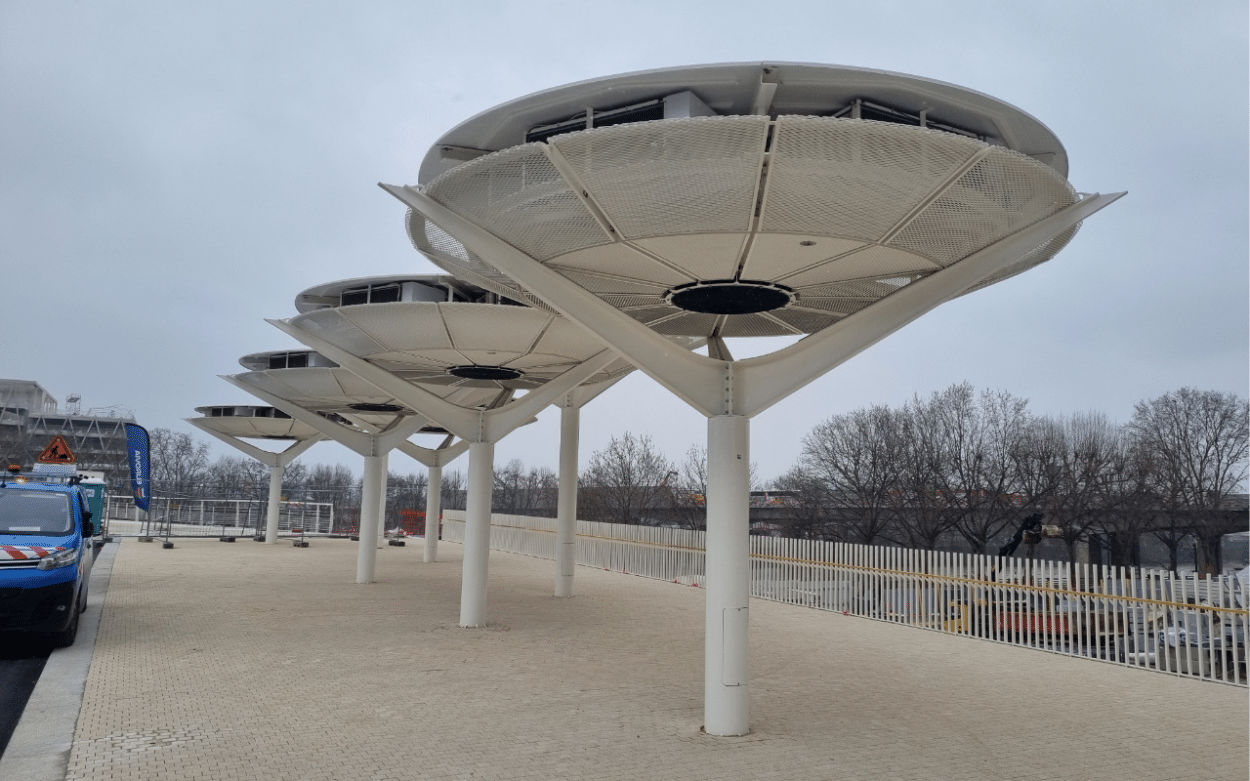Can polluted ambient air laden with fine particles be cleaned in large urban areas? Several companies are venturing into the market for large-scale air purifiers. In China, these large “vacuum cleaners” have notably made headlines in attempts to suck the smog and purify the air in cities like Beijing. In France, similar solutions are being explored. One of the companies, Aérophile, has even won a tender for the Paris Olympic Games. Five of their large air purifiers have already been installed around the Athletes’ Village, where the competitors will reside during the Games. We spoke with Mathieu Gobbi, the CEO of Aérophile, to learn more about the technology and its potential applications after the Olympics.
They have already appeared in Seine-Saint-Denis, near the future Olympic Village where athletes will stay during the Olympic Games. These gigantic parabolas, resembling flying saucers, aim to clean and purify the air in this highly polluted part of the eastern French capital, close to the motorway arteries.
These installations, which will remain after the Olympics, were developed by the French company Aérophile. This enterprise initially specializes in captive gas balloons for touristic purposes. Founded in 1994, one of their most famous attractions is the hot air balloon in André Citroën Park in Paris, tethered to the ground. Other captive balloons have been displayed across the world since then.
Measuring Air Quality
How did the company move to the air quality business? In 2020, Aérophile collaborated with AirParif (the air quality observatory in the Paris region) and the French National Center for Scientific Research (CNRS) to equip its Parisian balloon with pollution-measuring instruments. The idea was to study the fine particles that are responsible for respiratory problems, cancer, stroke, degenerative diseases like Alzheimer’s, and more.
Matthieu Gobbi, Aérophile’s CEO explains:
“We were curious to see how fine particles were distributed according to height. What’s particularly unique about our balloon is its ability to measure like a core sample. You know, in Antarctica, they take ice-core samples. Here, we’re taking an air core sample, measuring at different heights as we ascend throughout the flight. In Paris, the balloon can rise to three hundred meters. So we have measurements from 0 to 300 meters above a city, without disturbing the measurement in any way.”
This experiment led the teams to observe an interesting phenomenon: fine particles adhered to the balloon fabric more significantly than anticipated, exceeding what typically occurs on building facades on the ground.
The reason for this suction, Mr. Gobbi explains, is an electrical phenomenon:
“Since the balloon is connected to the ground by a cable, it has the potential of the earth. The fine particles around us at 300 meters altitude have a different electrical potential because there are significant electric fields. This difference in field means that at least some of the particles were attracted to the balloon instead of slipping away.”
It employs the same electrostatic principle as dusters: rather than dispersing the dust: if we use a charged solid, it causes the dust to adhere to it.
The idea of the pollution “vacuum cleaner” was born.
No Filters
While most air purifiers operate on the principle of paper or fabric filters, Aérophile’s innovation was to eliminate the need for mechanical filters.
The company has developed modules, the Para-PM, resembling electrical cabinets, measuring 50 centimeters by 50 centimeters in section and two meters in length. They can easily be installed, for example, in a corner of a factory.
They are composed of different stages. The first one ionizes the particles, charging them electrically to enhance their effects. There there is the agglomerator stage, where particles cling together to form larger, more easily captured particles. Then comes the collector, consisting of an array of aluminum plates.
In this collector, particles pass between highly charged metal plates with a strong electric field. Only suspended fine particles in the air are attracted and adhere to the plates. This is similar to particles adhering to the balloon’s fabric. However, the system requires numerous plates to generate a strong electric field, which necessitates close spacing between them to maintain a significant voltage difference.
With an electric field strength of several tens of thousands of volts per meter, the plates effectively capture the particles passing through the agglomerator.
Then an extractor fan, equivalent to four hundred watts, maintains air circulation. This results in a high airflow with minimal power consumption.


According to Mr. Gobbi, each module processes one cubic meter per second, equivalent to 3600 cubic meters per hour, capturing 95% of fine particles.
“In conventional air purifiers, the air is forced through a paper or fabric filter. This is where energy is expended because the air needs to pass through like a coffee filter. Gas molecules will pass through the filter, and particles will be trapped by the filter. Depending on the fineness of the filter, you can catch particles of varying sizes. The downside to all of this is that energy is needed to push the air through your mechanical filter. When you look at the electricity consumption, in China for example with their towers, it’s outrageous. Besides, the filters need to be changed from time to time. Whereas in our system, the air passes through our device freely. There’s nothing to slow it down. With very low energy expenditure, we have a very high flow rate, and we don’t have consumables because we don’t have filters that get clogged.”
In this case, it is possible to clean the air in large volumes, such as on the street. Collectors need to be cleaned every two or three years during maintenance operations.
The Olympic Games
Solidéo, the organization responsible for constructing the Olympic and Paralympic infrastructure, including the Olympic Games Athletes’ Village, selected this innovation. In this area where 14,500 athletes will reside with their respective staff during the Games, the proximity of the A1, and A86 highways, and the Parisian Ring Road tends to affect the quality of the air breathed. Hence, Aérophile’s air purifiers.
For the sake of urban furniture aesthetics, and since the air purifiers will remain permanently after the Games, Aérophile adapted its existing modules. This resulted in giant air purifiers shaped like flying saucers. Five of these devices, each containing six modules, have already made their appearance in the Seine-Saint-Denis Olympic area.
“Ultimately, this desire to create a circular design, which was not necessarily our initial intention, turns out to be technically more effective and truly relevant for the application in the athletes’ area.”
A “Shower of Clean Air“
The round system offers several advantages due to its design. By drawing in air from the periphery, and covering the entire outer circular area, the system maximizes the intake surface. This outer circumference, being the largest and longest part, allows for a gentle entry of air. This gentle entry facilitates better filtration by the devices, effectively removing fine particles.
As the air passes slowly through the electric field, a higher percentage of particles are collected, making the air even cleaner. Moreover, as the air progressively becomes cleaner, it moves towards the center of the system. With a fixed flow rate and a decreasing circumference towards the center, the air experiences an increase in speed. Consequently, the air accelerates as it undergoes purification and approaches the ground. Finally, the purified air is expelled from the device using a large circular fan located at the center.
“This setup creates a shower of clean air, with a vertical downward jet, under the canopies. As a result, the area beneath the system resembles a large parasol providing shade, along with a continuous supply of pure air, akin to a fountain.”
When the devices are in operation, the company claims that they will project 30 cubic meters per second of purified air under the canopies at a distance of 10 meters. Electricity consumption for one canopy containing five modules is one kilowatt. According to Mr. Gobbi, these will be able to filter 95% of fine particles. The noise level is around 60 decibels.
The air purifiers will also be equipped with electronic sensors that will help the management monitor alert thresholds and determine whether or not to activate based on pollution levels and weather conditions. For example, the purifiers will not operate when it is windy, as it would not be effective.
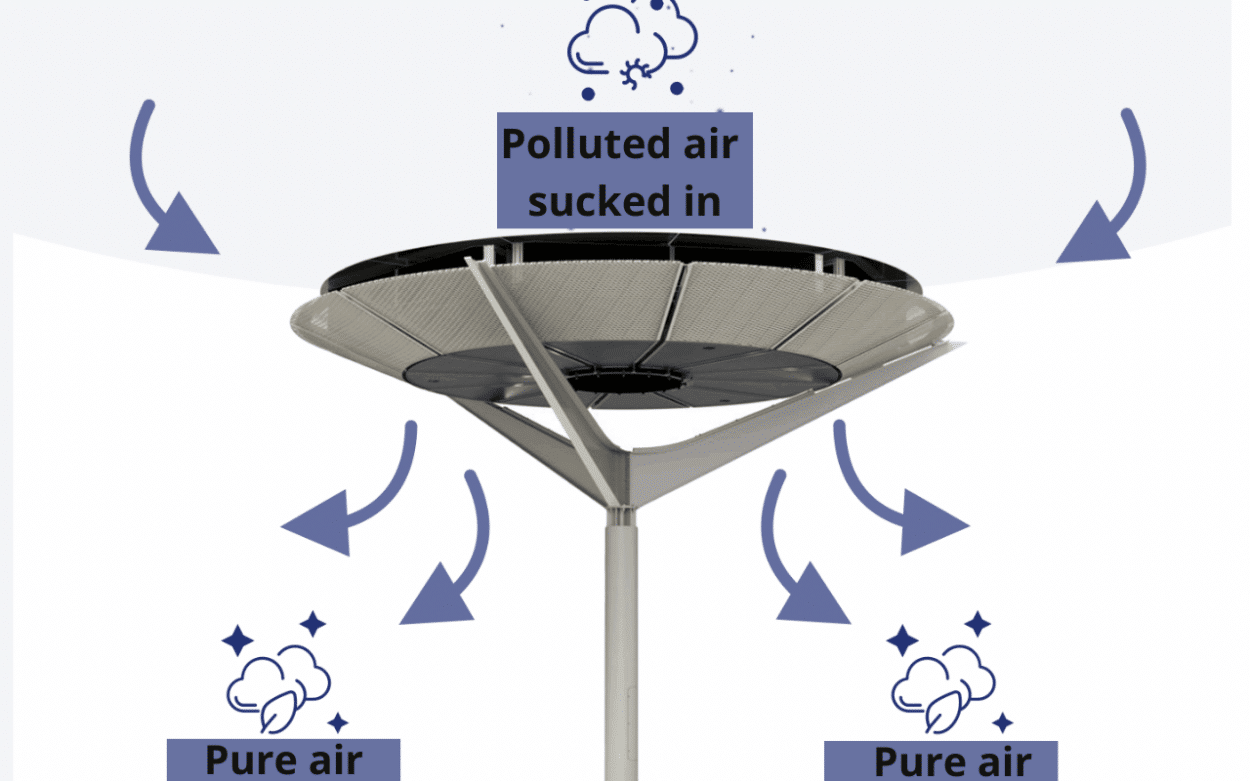


Additional Pilot Sites
Aérophile is currently testing its rectangular-shaped air purifiers at two other pilot sites: a school in Paris and the Lyon metro.
“We are waiting for administrative authorizations to install our devices in the metro. We will place about 10 of them spread across the two platforms. We know that metros are polluted areas. Today, when a train enters a metro station, it produces fine particles, especially during braking. But there is also resuspension, meaning that all the particles in nature are dispersed by the wind or washed down by the rain; in the metros, they settle on the ground after a while. But when the trains pass, they get resuspended. So each time there is resuspension, it will pass through our devices which it will clean up. I am convinced that we will clean something that has never been cleaned before.”
Industrial Applications
Could this technology also find applications in industrial facilities? Hospitals, along with the electronics, pharmaceuticals, and medical industries, already use extremely efficient systems in clean rooms. These systems involve airflow control mechanisms with stacked filters, which are highly effective and standardized, meeting regulatory requirements.
“Where we can be most relevant, I believe, is in industries where there is not much existing equipment or stringent requirements. For instance, in the steel industry. Another industry where we can make a significant impact is the automotive industry. Currently, the most effective way to clean the air is through HVAC systems with filters. However, older HVAC systems may pose challenges, as they require air extraction and then re-injection, leading to energy inefficiencies. During winter, for example, heating the air for re-injection can lead to significant energy consumption. Our solution offers significant energy savings in heating.”
Installing five or six modules against a wall could indeed dramatically improve indoor air quality.
Aérophile is also currently collaborating with engineering firms designing HVAC systems for renovations or new buildings. Their solution provides an attractive alternative by reducing the volume of heated air expelled, thus lowering heating energy consumption. Additionally, it reduces energy consumption in ventilation, as compared to traditional filter-based systems. This results in less pressure loss and improved filtration efficiency.
“Our solution is highly relevant for various building types, such as offices, and shopping centers, especially in polluted environments like near highways.”
Towards the End of Pollution?
Mr. Gobbi is realistic:
“We are not going to reduce air pollution across the entire north of Paris with our air purifiers; that is not the objective of the municipality of Saint-Denis. Human activity is such that it still emits a lot of fine particles, even electric vehicles will continue to emit fine particles because there’s braking, there are tires, electric vehicles are heavier.”
But for Mr. Gobbi, there is a future where this type of technology can contribute to reducing fine particle pollution in specific areas.
“If we take the Olympic Square, it’s a place where many people will pass through, where there will be a bus stop, and urban furniture installed. There will be benches, people will be able to chill, relax, and enjoy clean air.”
Price
The one-cubic-meter-per-second module costs around 12,000 euros.
“It’s not overly expensive. You won’t consume much electricity, and there will be a huge health benefit. So far, we have produced two series of ten. If the market expands, we will be looking for solutions to produce this in larger volumes.”
Last year, the company also raised eleven million euros.
